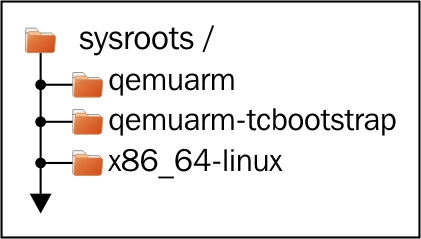Understanding the sysroot directories
The content of the sysroots directory is shown in the following figure:

We can see three directories: qemuarm, qemuarm-tcbootstrap, and x86_64-linux.
The qemuarm-tcbootstrap directory is used as an intermediate directory for the compiler bootstrap as it needs some artifacts (for example, the libc headers), which is only useful for debugging if working on toolchain development.
The
x86_64-linux directory is used (the name depends on the host machine architecture, for example, i686) to build host tools and libraries. The host sysroot is critical of the cross-compilation process as it provides the utilities used during the whole build process as pkg-config, autotool, make, git, and every other utility that is called during the build process; the binaries are built using the headers and libraries of the directory in order to isolate it completely from the GNU/Linux host distribution running in our development machine, and it is known as the host sysroot.
Our...
























































